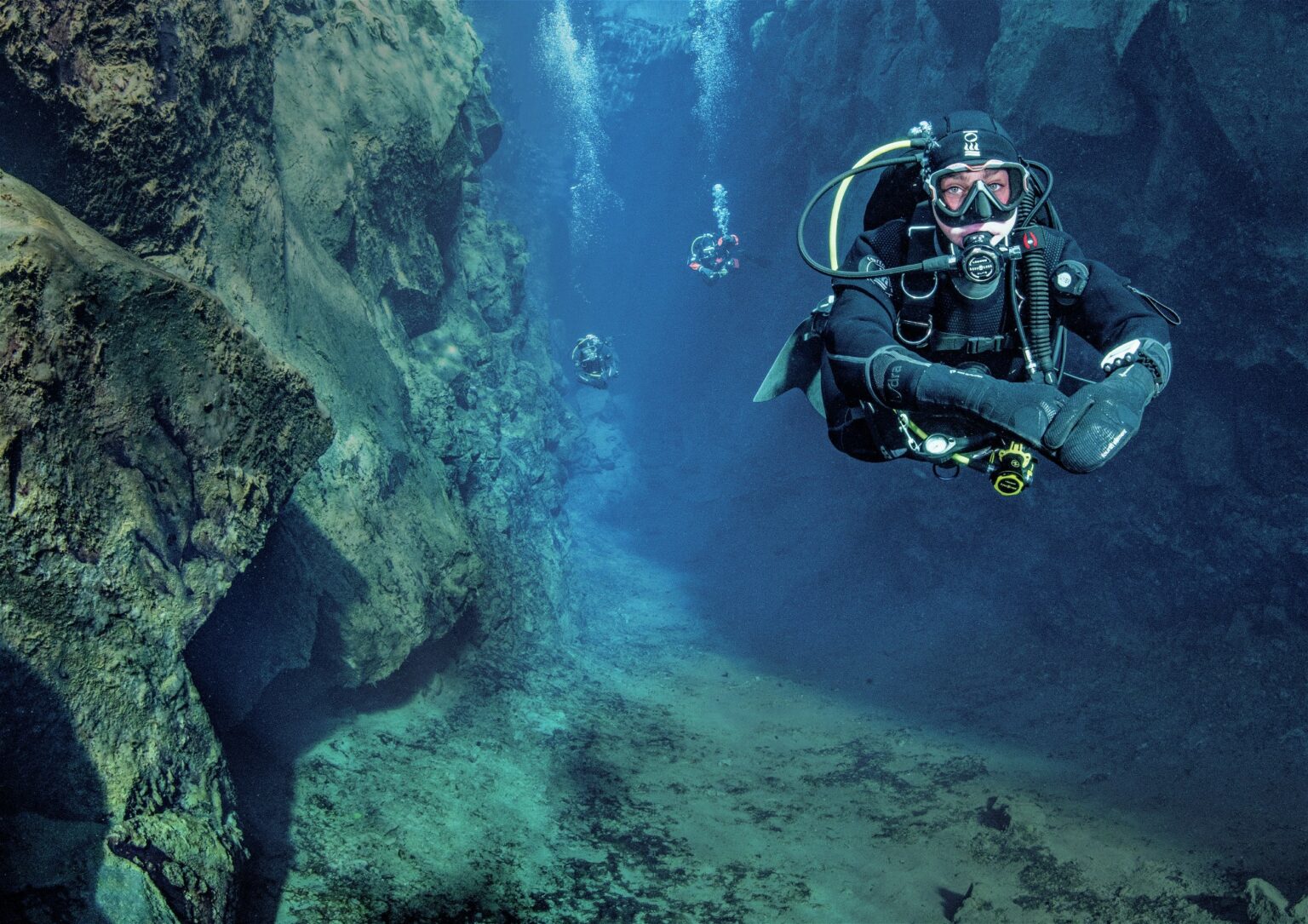Photographs by Eliska Mencova, Byron Conroy and Mark Evans
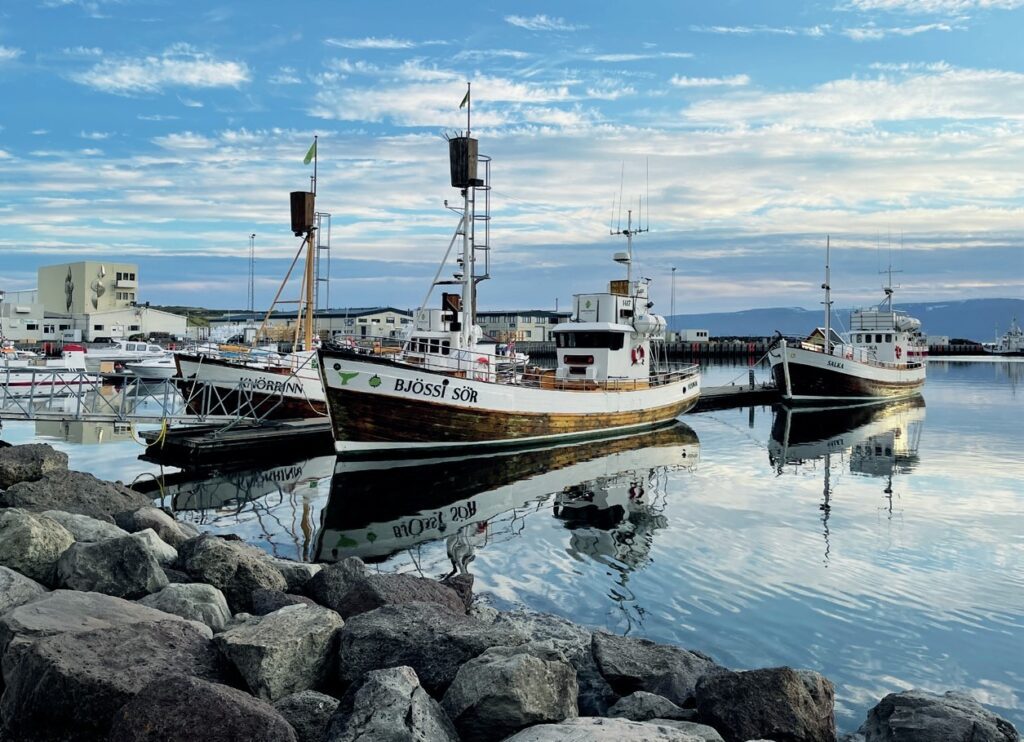
Iceland is one of those places that has long been on many bucket lists, and in September, the Evans clan – Scuba Diver Editorial Director Mark, wife Penney and then-15-year-old son Luke – embarked on an epic seven-day adventure around this amazing country.
After a ridiculously early 3am check-in at Luton, the flight to Iceland was swiftly despatched in a few hours, with us touching down at just before 8am. There was no time to waste as we had a truly action-packed itinerary planned, and so we were straight on the road with Arctic Adventures’ Eliska Mencova, who picked us up in a pimped-up off-road Toyota Landcruiser – much to the delight of Luke.
The day then saw us take in a series of impressive waterfalls, including the magnificent Seljalandsfoss, which falls some 60 metres over an old sea cliff. What makes this even more impressive is the fact that you can walk right around behind the falls – just make sure you have waterproofs on as you will get wet from the spray!
This was then topped by the immense Skogafoss, which delivered a stunning rainbow to greet us, and was worth the trek up hundreds of stairs to the viewing platform at the top which gives amazing views of the falls themselves and the surrounding countryside. After these epic waterfalls, we headed further south to the black sand beach at Reynisfjara. Game of Thrones was filmed in one of the massive caves, framed by unusual columnar basalt formations that reminded me of the Giant’s Causeway in Northern Ireland.
Did you know?
Jokulsarlon glacier lagoon is a truly awe-inspiring sight – the vision of icebergs serenely floating out through the channel to the open sea is both strangely calming and also visually intoxicating. A mesmerising location.
This was then topped by the immense Skogafoss, which delivered a stunning rainbow to greet us, and was worth the trek up hundreds of stairs to the viewing platform at the top which gives amazing views of the falls themselves and the surrounding countryside. After these epic waterfalls, we headed further south to the black sand beach at Reynisfjara. Game of Thrones was filmed in one of the massive caves, framed by unusual columnar basalt formations that reminded me of the Giant’s Causeway in Northern Ireland.
The nearby Diamond Beach – so-called because some of the icebergs from the glacier end up washed ashore on the black sand and break apart, eventually being worn away to resemble shiny diamonds – made a suitably dramatic end to a long first day, and we had a good night’s rest dreaming of our first day of Icelandic diving.
Into the Highlands
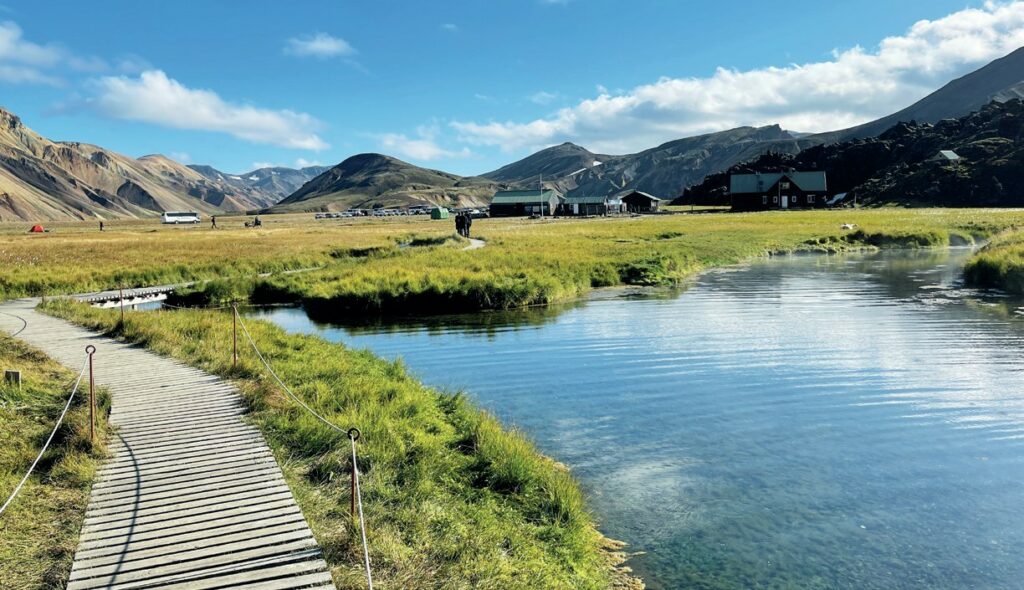
After a great night’s sleep and a filling breakfast, we took to the road again, but this time, we headed off-road into the Icelandic Highlands. We made a quick stop as the road turned into a proper rutted off-road trail, to lower the tyre pressures on our pimped-up Toyota Landcruiser, and then we were on our way to the first dive site of our trip – Odin’s Tear.
Odin’s Tear is a small, tear-drop-shaped lake in the heart of the Highlands, and it is an unlikely dive site, located where it is, but it is well worth the hours of off-road driving – and the 15-minute hike with all of your equipment to actually get to the water’s edge! The topside scenery surrounding this small body of water is stunning, but it is when you stick your head below the surface of the 3 degree C water that things really get awe-inspiring.
Imagine diving in a lake full of the purest mineral water on the planet and you’d be close to Odin’s Tear. The unreal clarity of the water is something else – our guide and photographer Eliska was playing with lighting some 50 metres away halfway across the 120-metre-long lake, and she was as clear to the eye as if she was a mere metre or so away. It is hard to explain just how clear this water is – you almost feel you are flying, it is only when you breathe out and your exhaled bubbles head for the surface that you remember you are underwater. After hauling all our kit back to the Landcruiser, we headed further into the Highlands through some of the most-amazing scenery I have ever seen, including several exciting river crossings, mountain climbs, steep descents, and much more.
A quick stop for a late lunch and a dip in the thermal hot river at Reykjadalur – which means ‘steam valley’ – to soothe aching muscles, and we were off again, eventually emerging from the Highlands in the west, reinflating the tyres and then taking the main ring road back into Reykjavik, where we were spending the night.
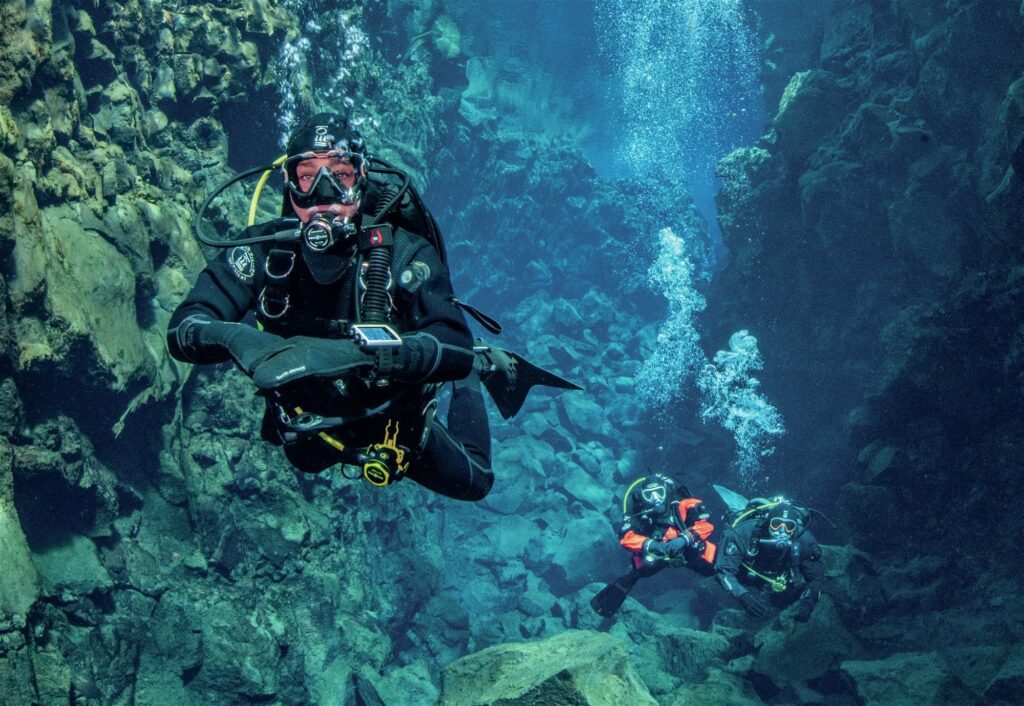
The continental divide
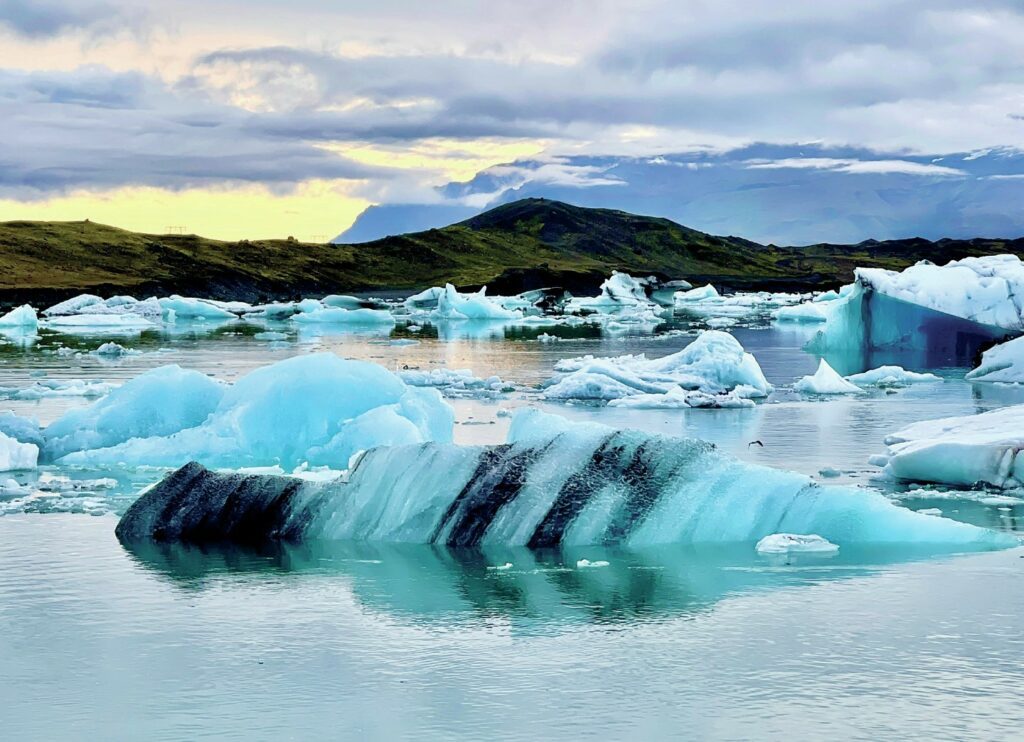
Day three in Iceland saw us back on the road after another good night’s sleep, and we headed out to Thingvellir National Park to dive that most-iconic of Icelandic dive sites – Silfra Rift. Silfra is a rift, or fissure, between the North American and Eurasian tectonic plates that was created back in 1789 by earthquakes as the plates moved slowly apart. Incredibly, the tectonic plates are still drifting apart at the rate of some 2cm per year.
Silfra was among a number of rifts that were created at this time, but it is the only one which tapped into a spring carrying glacial melt-water from the Langjokull glacier. It is thought the water takes some 20-30 years to make its way from the glacier through the lava rock into the spring that runs into Silfra, meaning the water you dive in is some of the purest, cleanest mineral water on the planet – carefully taking your reg out to have a sip is incredibly refreshing! It is also unbelievably clear – the vis is well over 100 metres, it is like being topside.
However, coming from the glacier and then spending decades underground does mean that the water is cold – expect 2-4 degrees C (we got 3 degrees C on our dive).
Silfra Rift is definitely a bucket list dive – even if you are not a cold-water diver, it is worth getting your drysuit cert purely to log this one dive. It is simply breath-taking, both from the incredible vis – and from the cold water!
Once we’d de-kitted, loaded up the Toyota – this time with a trailer for extra cylinders for our next diving location – and warmed up, we got back on the ring road heading north for several hours round to Akureyri, the second-largest city in Iceland, passing more stunning scenery enroute. After the long drive around the ring road to Akureyri, we got to our little cosy cabin – our home in Iceland for the next three nights – and got our heads down for a good night’s sleep, but not until we’d had a tasty BBQ and a spell in the hot tub watching a stunning display of the Northern Lights. What a way to wrap up day three!
Did you know?
Iceland is home to myriad gigantic waterfalls, including Skogafoss and Seljalandsfoss.
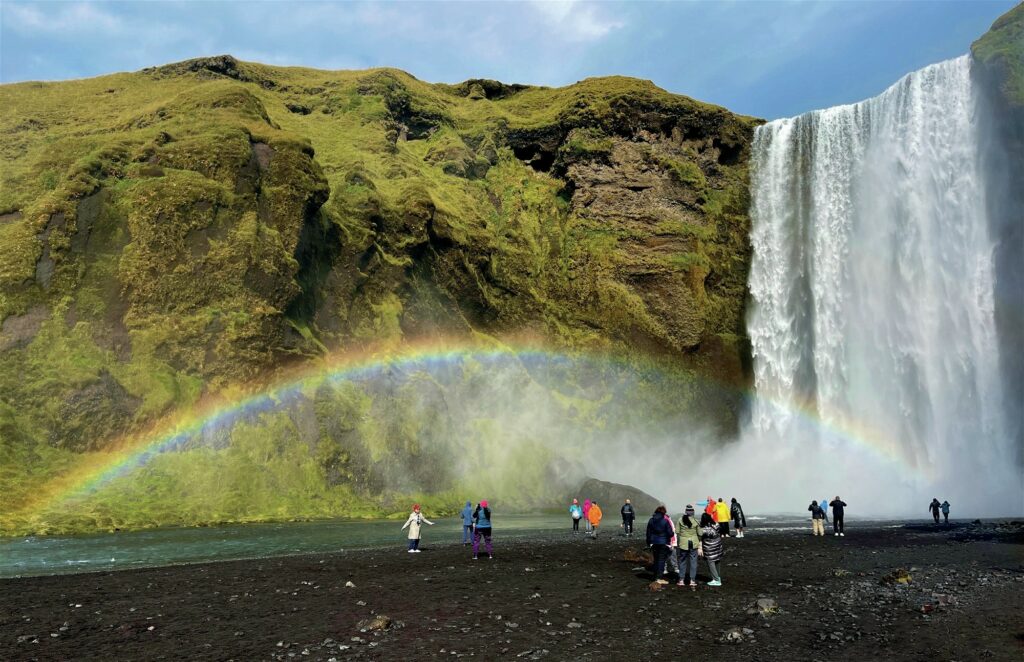
Getting prehistoric
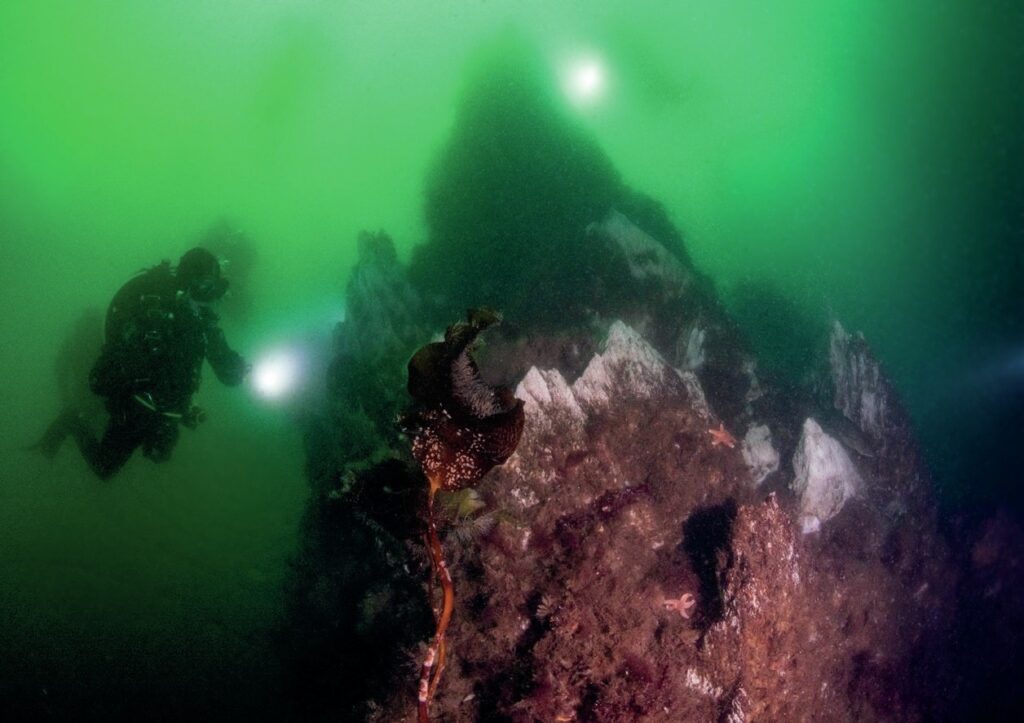
Waking up to a frosty morning, we made the short drive to Strýtan Dive Centre, a PADI five-star centre operated by Erlendur Bogason for more than 25 years. Erlendur is a real character, and he is the custodian of what we had come to see – the Strýtan hydrothermal chimney – having discovered it in 1997.
Strýtan is the only hydrothermal chimney that is accessible for scuba diving – all other known chimneys like this are at 2,000m–6,000m depth. Strýtan stands tall and alone in the middle of Eyjafjörður, rising from 65m to 15m. It was formed over 10,000 years ago and you can see in some areas where it’s still building. There are around 100 litres of 72°C freshwater coming from the chimney every second.
Before we got to dive Strýtan, we first made a dive on another hydrothermal chimney, Arnarnesstrýtan, which is much smaller and only lies in 22m-24m, but still has vents pumping out hot water from inside the Earth. The highlight of this dive are undoubtedly the wolf fish which call it home, and we found several nestling inside rocky crevices, a couple with egg balls. There are also swarms of large cod that get up close and personal, along with flatfish, starfish and more.
A surface interval in glorious sunshine followed, and we were treated to humpback whales on the surface as we munched on chocolate bars and drank warming coffee, then it was time for the main event – Strýtan.
Dropping down the rope from the boat, we came to a large submerged buoy – this is anchored to the seabed some 60m plus down. At around 22m, we came across a rope that led from this line to the chimney itself at around 25m-27m. Once on the chimney, we made countless circuits of the towering structure, slowly heading up to the highest point at 15m.
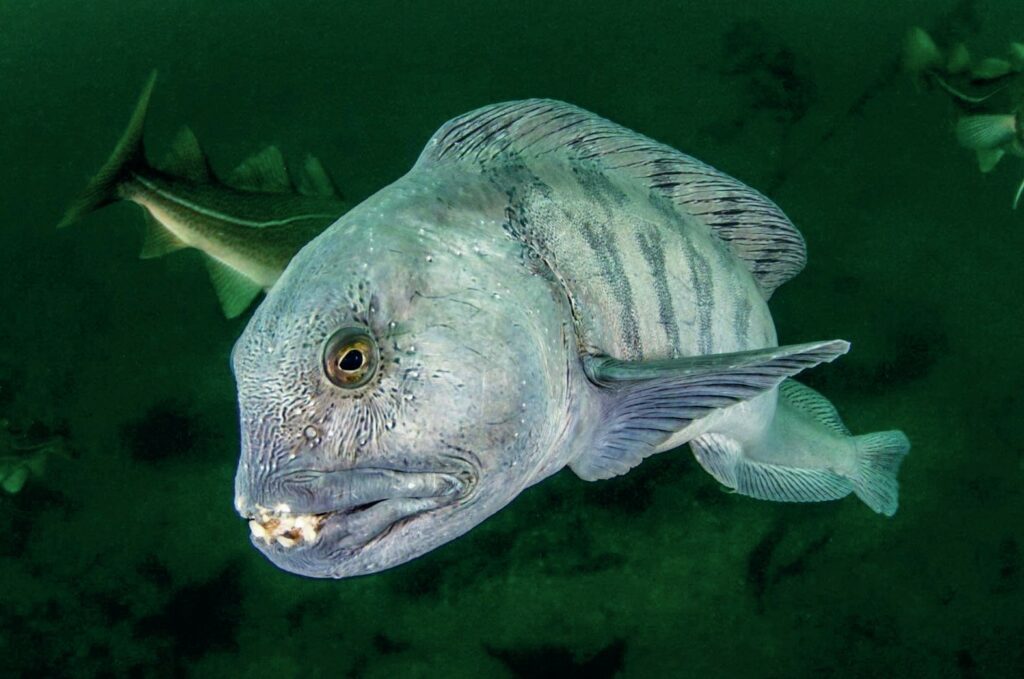
The Strýtan has an unreal presence – you feel like you are witnessing something truly ancient and prehistoric. The vents spewing out hot water were bizarre, and through the haze of the thermocline, you can see ghostly white areas where the tower is still growing. There is also plenty of marine life around, but Strýtan takes all of your focus on this dive. After another sleep-of-the-dead – this cold-water diving lark gets tiring! – we awoke to a crisp morning and headed back to Strytan Dive Centre to explore more of the area on our Arctic Adventures odyssey.
Our return visit to Arnarnesstrýtan was an eye-opener! The vis for the first 10m was poor, but once we hit 15m, it cleared up dramatically to a good eight to ten metres. It was like a completely different dive to our first visit!
The cod swarmed in as soon as we reached the seabed, along with a friendly wolf fish, and then we spent a good 40 minutes slowly circling the structure and seeing many wolf fish huddled in their holes, along with scorpionfish, myriad nudibranchs – once I got my eye in, they were everywhere, especially near the vents – and yet more cod. It proved to be an epic final dive of the trip.
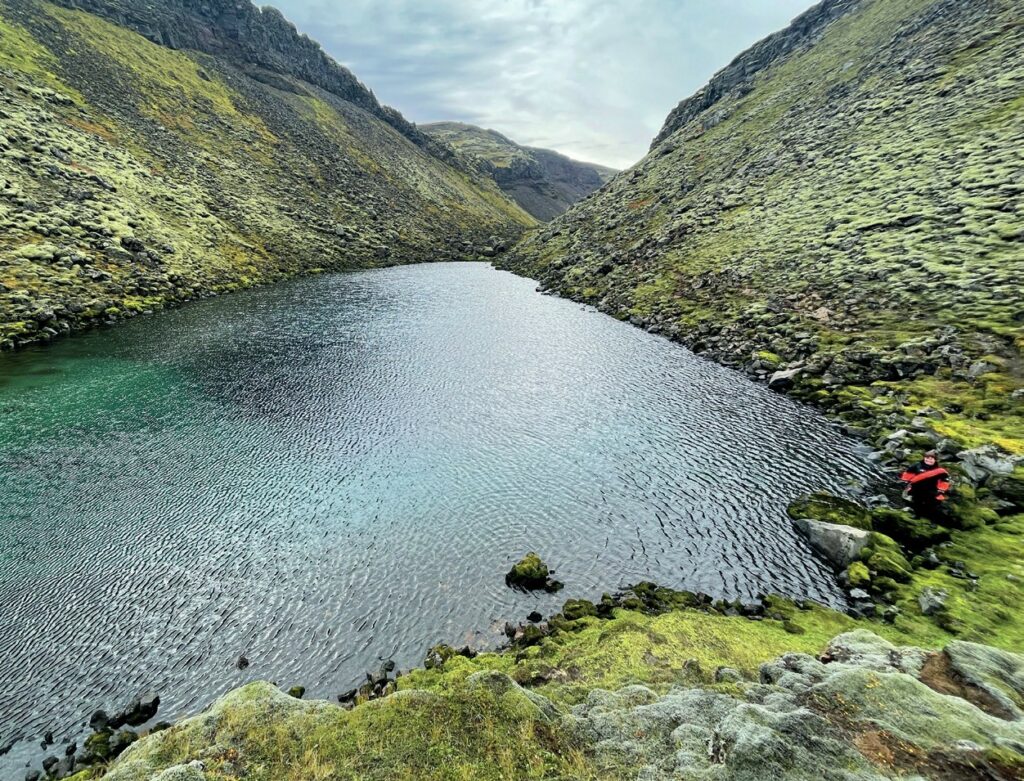
Into the glacier
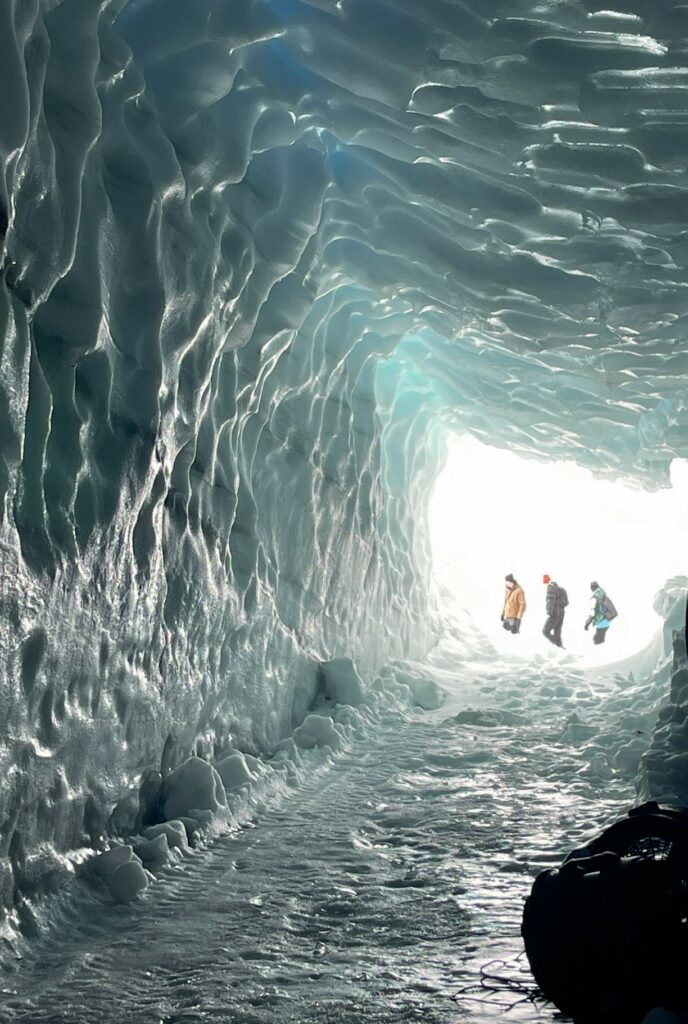
And so began the final day of our Iceland expedition, and we set off from Akureyri and headed back round the ring road towards Langjökull, the country’s second-largest glacier. We were joining Into the Glacier to do just that – actually head inside the glacier itself via the largest manmade ice tunnel in the world.
What lay beneath the surface of the Langjökull glacier had been a mystery, known only by a small group of scientists and glaciologists, then in 2010, Baldvin Einarsson and Hallgrimur Örn Arngrímsson had a bold and daring vision – to take people not just around and onto the glacier, but also inside the heart of the remote and extraordinary ice cap, to see the magnificent ‘blue ice’ which is buried deep beneath the surface.
With this bold vision in mind, top engineers and renowned geo physicist Ari Trausti Guðmundsson began studying, planning, modelling and carefully preparing for construction. What started as a dream rapidly became a reality, as passion, energy, enthusiasm and drive, combined with science, engineering, finance and political support, made it possible to shape the first – and biggest – manmade ice cap glacier ice cave.
Just getting to the entrance to the cave is a mission in itself, as it lies high up on the glacier, so first you get into an off-road coach to get to the base camp just beneath the glacier, and then you board a monster eight-wheeled glacier truck to drive up on to the ice and get to the cave entrance.
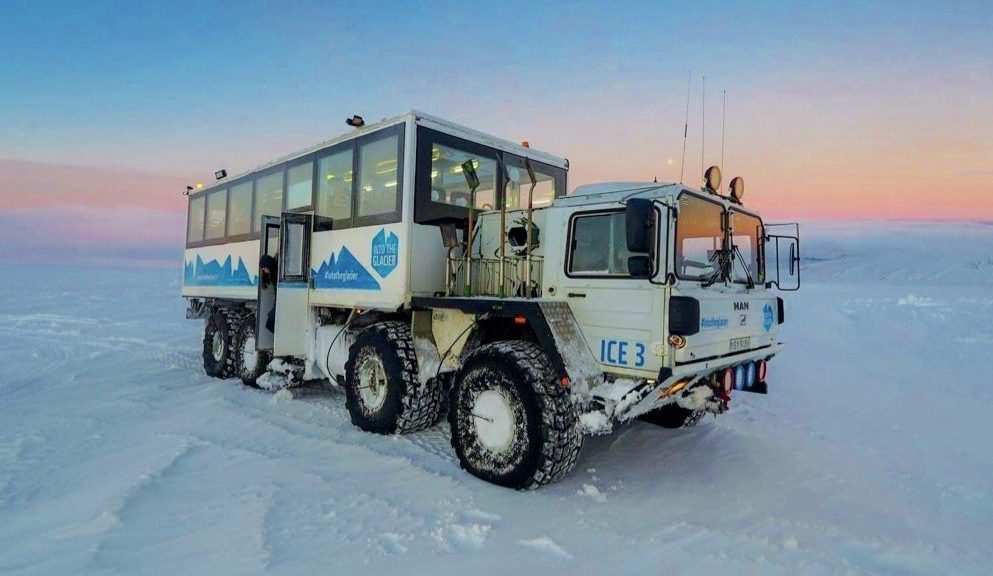
We were wrapped up warm in multiple layers, but we were equipped with waterproof overboots and jackets to keep us dry inside the cave. Once at the tunnel entrance, we walked in a hundred metres or so along carpet until we were given crampons to slot over our boots. We were then set to venture further into the tunnel system.
Did you know?
Silfra Rift is the name given to the fissure between the North American and Eurasian tectonic plates that was created way back in 1789 by earthquakes as the plates moved slowly and inexorably further apart.
Our guide Adrian took our group through the winding passages and rooms, which are well lit throughout, giving them an ethereal look which really emphasised the white and blue colours of the ice. Along the way he told us what makes a glacier, how crevasses are formed, the rate at which this glacier is disappearing, and much more. Only a tiny fraction of the glacier was removed by the tunnelling, and when the operation eventually wraps up, the tunnels will disappear as the glacier moves and compresses, but being able to see beneath the icy surface was a truly eye-opening experience.
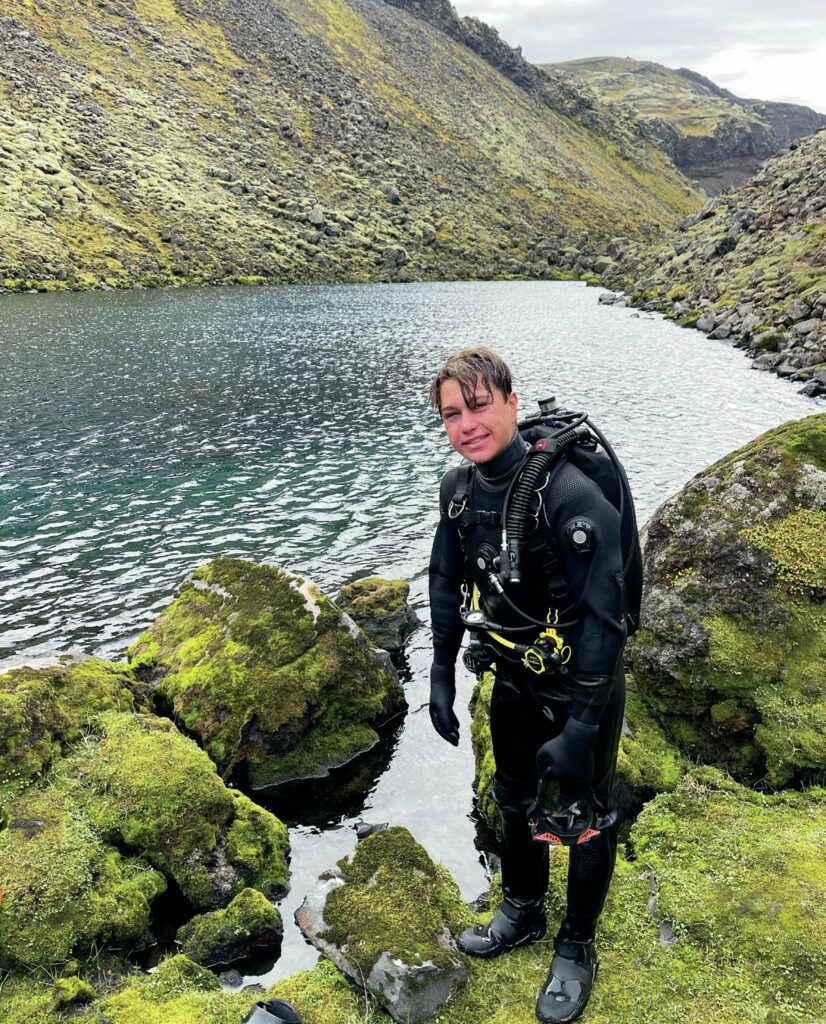
In summary
Our Iceland adventure was a true expedition, and we crammed an awful lot into our six days on the road. We covered some serious mileage in our ‘Arctic Trucks’ Toyota Landcruiser, including river crossings and rough off-roading through the Highlands. We saw icebergs drifting gentlly out to sea. We dived in a mountain lake with impossibly clear water. We relaxed in hot thermal rivers and baths. We explored hydrothermal chimneys swarming with marine life. We saw humpback whales on our surface intervals. We marvelled at majestic waterfalls. And, of course, we dived Silfra Rift between the American and Euroasian continental plates. Plus, we were treated to some spectacular scenery throughout our epic journey around this stunning country.
Some may bring up Iceland’s whaling traditions, but there is only one commercial whaler left, his sons have no interest in continuing the family business, and the government is looking to ban the practice in 2024. Plus, the more people who partake in tourism on the island, including whale watching, the less likely it is that whaling would ever be considered viable in the future.
Some may bring up Iceland’s whaling traditions, but there is only one commercial whaler left, his sons have no interest in continuing the family business, and the government is looking to ban the practice in 2024. Plus, the more people who partake in tourism on the island, including whale watching, the less likely it is that whaling would ever be considered viable in the future.
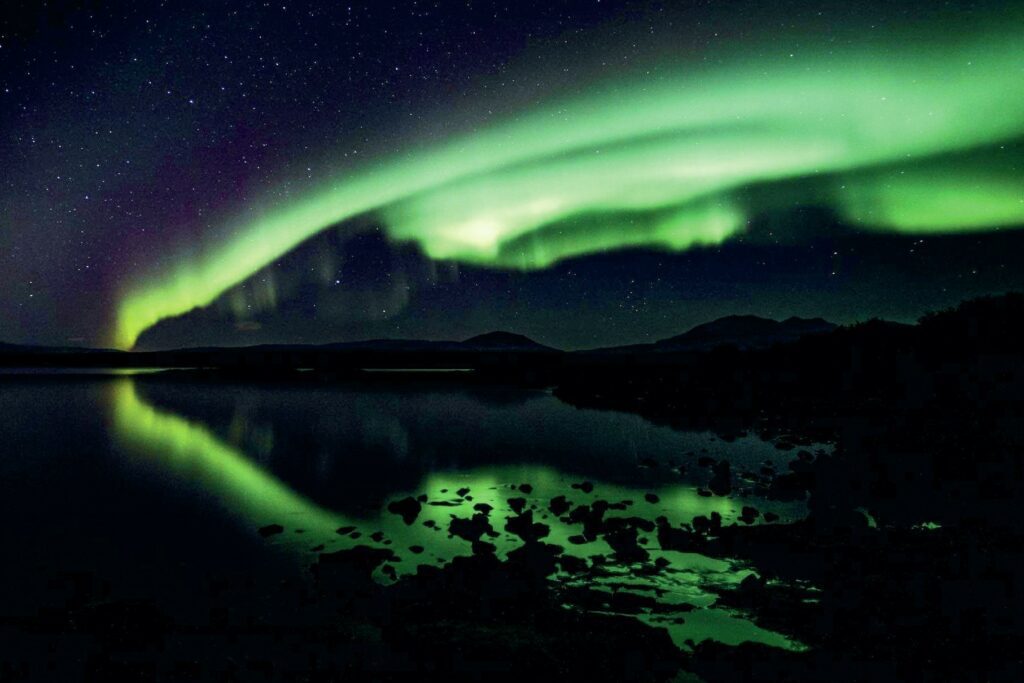
Arctic Adventures are one of the largest operators on the island, and they are a true one-stop-shop, able to assist with guided tours, self-drive tours, accommodation, and innumerable activities, including diving, whale-watching, snowmobile expeditions, hiking, and much more.
This article was originally published in Scuba Diver UK #69.
Subscribe digitally and read more great stories like this from anywhere in the world in a mobile-friendly format. Link to the article
